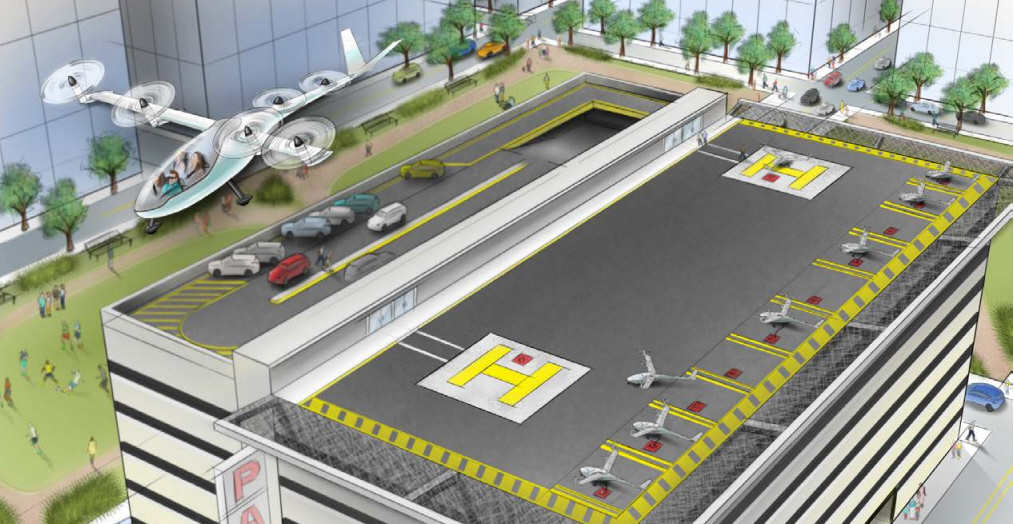

Uber, the massively successful app based around the convenience of summoning a car to take you home from a bar at last call, is ready to embark on a new frontier: flight. In a white paper published today, Uber says the next stage of transport is a network of app-summoned vertical-takeoff (VTOL) aircraft for elite commuters.
Last month, Uber revealed it was looking into VTOL technologies, to take advantage of that great uncrowded highway above every city: the sky. Now they’ve got a more detailed pitch.
At Popular Science, we have a long history of optimism when it comes to commuting by air, with flying cars gracing our covers from March 1926 to March 2006, with several more in-between. While technologies, materials, companies, and ambitions have all changed in the ensuing 90 years of flying car speculation, the challenge of building a vehicle that works on both streets and in the air remains hard.
The history of VTOL aircraft is filled with failure after failure after expensive failure, and only a few success stories. The V-22 Osprey, a military aircraft used to carry Air Force special operations forces and Marines into hard-to-reach places, was not an easy plane to design. It took the better part of two decades, with full military budgets and need behind it, to get the Osprey working reliably, instead of crashing and killing its occupants. It cost about $54 billion to develop the aircraft, and each one costs $70 million.
So Uber is mostly skipping the car part, instead making a plane that takes off and lands like a helicopter, and designing it to fly from helipads. Helicopters–an existing, proven technology–already meet most of the needs for Uber’s planned flying machine, but they’re too slow for the commuter flights of 20 minutes or less that Uber wants from urban hubs to residential suburbs (or the downtown hubs of suburban areas). To meet this, Uber wants an aircraft that can fly between 150 mph and 200 mph. That’s speedier than all but the most cutting edge military helicopters, but within the range of VTOL aircraft–which is why Uber wants it to switch to flying like a plane once it’s off the ground. On top of all that, the company wants the vehicle to be all-electric, to keep down noise and emissions.
Uber anticipates a 43-mile VTOL flight from San Francisco’s marina to downtown San Jose taking just 18 minutes. Cars, unable to fly unimpeded over the bay, are limited to 55-mile routes, with a travel time of over 100 minutes. The company expects it can price the flights competitively, with an initial $129 VTOL fee compared to an UberX trip between the same two points costing $111.
Of course, part of what makes Uber work as a business is the company’s staunch aversion to labor costs. Wherever it can, Uber classifies its drivers as independent contractors, keeping costs down even while paying expensive labor settlements. The pool of possible Uber drivers is not quite as large as everyone with a driver’s license and a car, but it’s pretty close, so Uber’s not hurting for drivers. But certified pilots, and especially pilots certified to fly a brand new kind of VTOL aircraft, will likely not come cheap. And, given the FAA’s reluctance to reduce piloting requirements for unmanned vehicles, it will be hard for Uber to automate its VTOL passenger craft, a goal stated in the white paper, the way it’s planning on rolling out driverless cars.
Beyond the challenges of building a new aircraft from scratch and training and paying pilots for it, there are the standard regulatory obstacles, which in the past Uber has aggressively skirted around and campaigned against, though that approach may be changing. Besides individual cities, Uber will have to work with the FAA, the federal agency that regulates all airspace in the United States. The white paper tackles this head-on, promising compliance with expected stricter noise regulations and aerial traffic laws. Carving out new sky lanes for traffic, and hew spots for heliports in cities, are another anticipated set of challenges.
That’s an ambitious slate to tackle for any company, and VTOL technology has an extensive track record of failure. And if it’s successful, we’ll probably need some new vocabulary. No one wants to say they took a “VTOL passenger aircraft” to work, and “flying car” is more misleading than it is helpful. I suggest ‘Icarus.’
